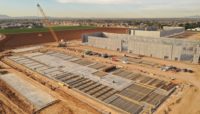Water is lifted 1,000 ft by the three pump stations between North Campus and Binney. Forebay tanks at each pump station provide extra storage capacity—9 million gal. in all—in the event of pipeline shutdown and to compensate for pump-rate imbalances between stations.
A dual-pump configuration provides flexibility and a 25-million-gal.-per-day capability.
“Prairie Waters is somewhat unique in its use of multi-step purification and puts Aurora center stage in the application of advanced water-treatment technology,” Marciniak said. “At Binney, up to 50 million gal. of water, depending on demand, is passed through a succession of 13 treatment buildings. The ultimate goal is to ensure that water from Binney be indistinguishable from the mountain-sourced water stored in Aurora Reservoir.”
The entire system is monitored and operated by a single technician from the computerized control center at Binney. Data is transmitted via fiber-optic cable running parallel to the pipeline. “The high-tech control system, including numerous valves and monitoring devices, was a huge component of the project,” Marciniak said.
Even though they are part of a “campus,” Prairie Waters’ facilities are intended to resemble an office park rather than an industrial installation, and they blend naturally with the surroundings.
Linked by paved roads, the buildings at Binney feature handsome standing-seam metal roofs and cultured-stone siding that resembles local rock outcroppings. Native landscaping between buildings enhances the facility’s office-park ambiance.
The pump stations mimic farm buildings to fit their pastoral settings.





Post a comment to this article
Report Abusive Comment